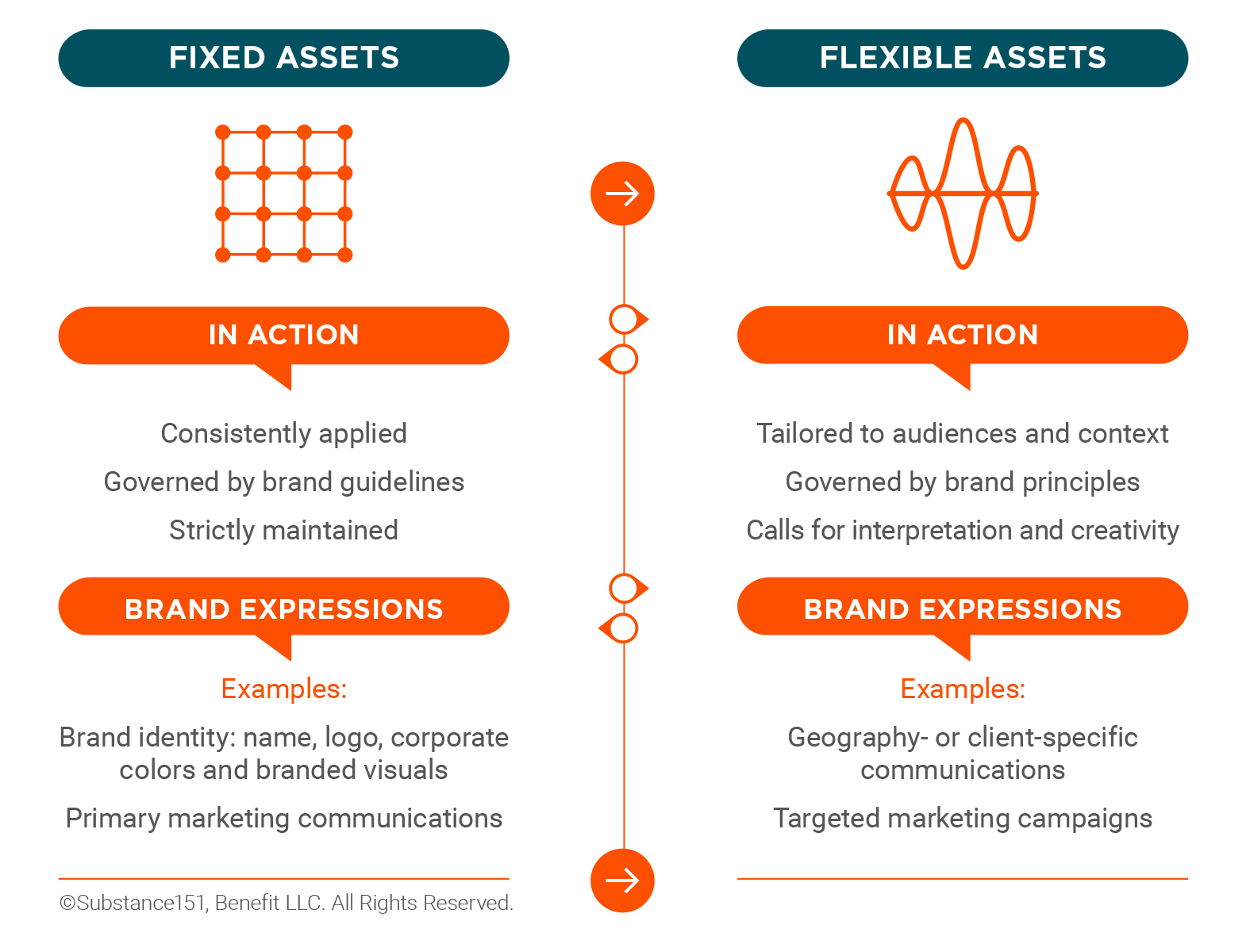
In the past, brand management was about managing the identity of a company. It involved developing a brand strategy and brand platform, creating verbal and visual identity, establishing strict brand guidelines and monitoring marketing communications for brand consistency. Marketing, on the other hand, was focused on defining, managing, manipulating and executing the strategy for offerings (product), distribution (place), pricing and promotion. Remember the 4Ps?
Today’s brand management involves much more than maintaining consistency of a brand’s identity, and the old siloed approach to branding and marketing must give way to a cross-functional, multidiscipline, and collaborative approach. The approach that’s far more effective in combating the new challenges that are brought about by the speed and all-encompassing nature of change for all organizations of all industries and sizes, specifically:
To overcome these challenges, today’s brand management can’t revolve around simply maintaining the consistency of image and message – it must be focused on the constant and active creation and growth of a brand’s equity and on strengthening a brand’s ability to steal market share away from competitors.
Doing this requires mastering a whole new mindset, as well as new skills and a cross-functional approach, supported by the company leadership and involving everyone within the company.
Let’s take a deep dive into what it takes to successfully manage your company’s brand today and in the future.
Today’s multiscreen, media-rich, omnichannel environment creates never-before-imaginable opportunities for brands. But its fast-paced, always-evolving nature also presents challenges at every turn. Given the fluid nature of the environment in which brands now live, and the fact that we no longer have full control over how our brands are experienced, how we develop and manage brands also needs to evolve.
Brands (and teams managing them) must embrace the unknown – unknown situations, applications and media channels. They must not only consider but also leverage the ever-changing context.
Brand management practices need to shift from:
In short, effective brand management requires changing the view of brands as collections of symbols and artifacts and embracing the idea of brands as always evolving systems. Being on-brand is no longer the same as being in compliance with graphic standards.
What does it take to be “on-brand” today?
First, companies must start thinking about their brands not as logos but as experiences through which all stakeholders – internal and external – interact, and therefore form an opinion of, and relationship with, the brand.
Second, companies must understand that what people experience when they come in contact with their brands is brand behavior. The most significant organizational change around brand management is the shift from enforcing brand rules and compliance, which are process-based, to fostering desired brand behavior, which is culture-based.
What this leads to is critical:
In the new brand management, behavior is the linchpin – and people determine behavior.
But what “people”?
The simple and most valid answer is everyone, but not in the same way.
Why? Because not everyone is equally qualified to make critical decisions about the brand and not all decisions on behalf of the brand are equally important.
There are four main groups of brand decision makers:
Brand owners are steeped in knowledge about the company and its brand and have the business, strategic and creative skillsets and branding experience to:
Brand owners typically include the company’s leadership and top brand and marketing titles, as well as outside branding experts.
This group spearheads strategic branding initiatives and activities and makes decisions about when to launch a new branding campaign, conduct an internal brand audit or rebrand.
For most companies, the balance between in-house and outsourced brand owners skews toward the latter because developing brands requires highly specialized multidisciplinary expertise and skills. And although every company should have an internal brand manager, it is not unusual for the CMO to play that role, working closely with an outside agency.
Brand agents are responsible for day-to-day brand management across all of a company’s marketing channels and brand touchpoints, as well as for adapting the brand to create regional and cultural relevance.
Brand agents include internal branding, marketing and communications teams. Sometimes the work of brand agents is outsourced to branding or marketing agencies and/or consultants with specific skills.
This group is more knowledgeable about the company’s brand, as well as branding and marketing principles and practices, than other employees and needs to be trained and empowered to make day-to-day decisions related to executing against the brand and managing its assets.
Brand agents also need to understand when a brand-related decision is too important to make without the input of the brand owners.
Brand ambassadors represent and speak for the brand and understand how to be “on-brand” when they’re interacting with the outside world – whether in a meeting with a customer or when answering the question, “What do you do?”
The ambassadors group includes all employees. Whether they have direct contact with customers or not, they are the force behind delivering on a company’s brand promise and validating its marketing message.
This group doesn’t need to understand technical aspects of the brand, such as how to use the company’s brand assets, because it’s not involved in creating marketing communications. But brand ambassadors do need to embody the brand and understand, through ongoing brand education, what it means to be on-brand with their behaviors and actions.
Brand champions advocate for the brand from an objective, outsider perspective.
This group includes your current and past customers, vendors, board members, investors, strategic and business partners, former employees and other external stakeholders.
How accurately (or not) brand champions represent a company’s brand depends greatly on how precisely and powerfully a brand has been defined and communicated by that company.
If a brand is the perception others have about your company, and if branding is how you control that perception, then what your brand champions say and do is a direct reflection of how well the brand owners, agents and ambassadors are doing their jobs.
Growing and sustaining brand equity – the goal of brand management – requires more experience, global thinking and continual attention than ever before. Companies need to maintain a careful balance between protecting their brand from becoming too diluted, fragmented and inconsistent and allowing it the freedom to adapt to current context and evolve over time, ensuring it remains meaningful and relevant to those who experience it.
The balance between being too rigid and letting go too much will be different for every company. Consider what will be required to maintain the integrity of your brand. Less flexible systems require less time and fewer resources. It’s easier to develop clear guidelines for a smaller number of brand expressions. Plus, implementing a fluid system can be more costly.

How flexible can you be with your company’s brand assets and who gets to decide? The answer depends on these key factors:
Remember that having the ability to flex your brand offers far more options, but also requires much more hands-on guidance from brand owners, and higher level skillsets and expertise of brand agents.
Once you’ve considered the above factors, decide what makes sense for your company and where its brand needs to be on the scale of fixed to flexible.
Brands live through the company’s culture, so actively managing the brand inside the organization is essential. This means that employee experience (EX) must align with the customer experience (CX) and all the external brand expressions (read more about aligning brand, CX and EX).
With the traditional brand management model focused entirely on preventing the brand from getting “messed up,” the goal was to establish, teach and enforce strict brand rules. The new brand management, however, is about making sure all stakeholders are deeply entrenched in the brand so that they’re able to deliver on the brand promise in every situation.
This shift in mindset requires those responsible for how a brand is seen and experienced by the outside world to become true brand advocates, not brand keepers. To facilitate this fundamental organizational and cultural change, internal brand training and education is more important than ever – and just like branding itself, it’s an ongoing process, not something you can check off the list.
Of course, brand guidelines still apply and need to be created and referenced, but the guidelines are simply a framework for making decisions about the brand. Educating a firm’s leadership, marketing and all employees about the “why” behind the brand and its assets (message, image, materials, communications, etc.) is now as important as the “how” of using those assets.
The exact strategies and tactics you’ll use to manage the brand inside and out may vary, but the goal is always the same: Take advantage of opportunities, through thoughtful and proactive brand management, that continue to grow your company’s brand equity over time.
Brand Strategy Playbook
Do You Understand the Anatomy of Your Brand?
Anatomy of a Brand [inforgraphic]
Branding Evolved: The New Brand Management Manifesto
Download a free PDF of this article here.